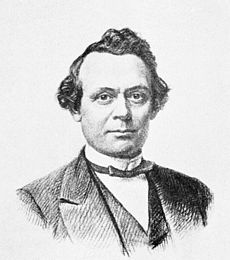Worsaae was, moreover, a writer of force, and his archaeological books and lesser writings are classical. The prehistoric chronology of Denmark suggested by him is practically that now used by all students; it is about as follows:
| Stone age. | (a) Earlier | 3000 to 2000 b. c. |
| (b) Later | 2000 to 1000 b. c. | |
| Bronze age. | (a) Earlier | 1000 to 500 b. c. |
| (b) Later | 500 to 100 b. c. | |
| Iron age. | (a) Pre-Roman | 100 b. c. to 100 a. d. |
| (b) Later | 100 a. d. |
Thus fortunate in its early directors, the museum is no less fortunate in having for its present director a worthy follower of

|
| Fig. 2.—J. J. A. Worsaae. |
these two great men. Sophus Müller is ably carrying on the work of Thomsen and Worsaae. Assisted by a competent corps of helpers, the museum is vigorously prosecuting the work of field collecting, noting, mapping, and preservation of Denmark's antiquities. Dr. Müller has recently produced two important volumes entitled Ordning af Danmarks Oldsager. Volume I is devoted to the stone age, Volume II to the bronze age. The third volume, upon the iron age, is in preparation. In these works every type of Danish archæology is carefully described and the very great majority accurately figured. The text is Danish, but a résumé in French accompanies it; the pictures, of course, speak all languages (Fig. 3).
In Danish archæology there is no palæolithic period. Glacial deposits abound in Denmark, but so far evidence of man's existence there at that time is lacking. Very shortly after the ice retreated man must have appeared, and from that time on both the islands and Jutland have been occupied by busy, active, progressive men.
The oldest monuments seem to be the shell heaps or kjoekkenmoeddinger. These abound along certain parts on the coast, especially along the Kategat and elsewhere in Zealand and in Jutland. They are heaps sometimes hundreds of metres in length, dozens of metres in width, and as much as three metres in thickness. They consist mainly of the broken or entire shells of ma-
